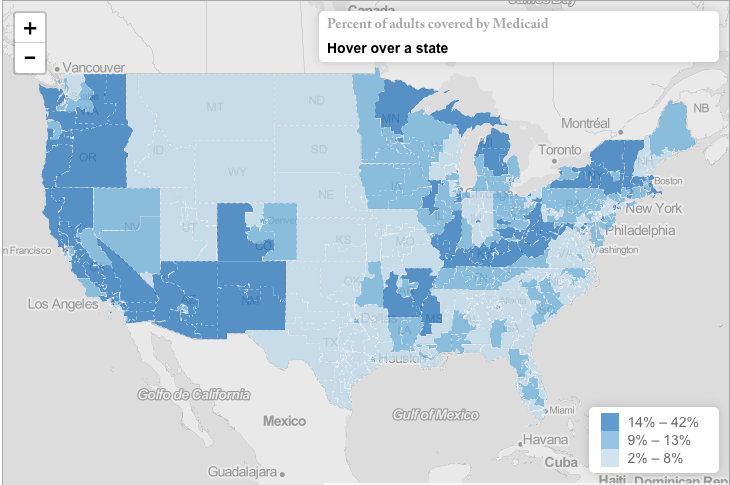Alaska
-
Medicaid’s Role in Small Towns and Rural Areas
Key Findings Background One-fifth of people in the United States live in areas that are classified as non-urban. Residents of rural areas and small towns face additional challenges accessing needed health services compared to residents of metro areas for a variety of reasons including acute provider shortages, limited connectivity, and long distances to travel to…
-
State Medicaid and CHIP Snapshots, 2023
The Georgetown University Center for Children and Families (CCF) and the American Academy of Pediatrics (AAP) created factsheets underscoring the importance of Medicaid in providing coverage for children in all 50 states and the District of Columbia. Sources available here. Previous snapshots can be found here (2019), here (2018) and here (2017). Check out more interactive…
-
2016 Maps
The interactive maps and data for 2016 provide information on the percent of adults and children covered by Medicaid and/or CHIP.You can embed these maps on your website by selecting a state on the left then copying the embed code on the right side of the map and pasting it into a post on your…
-
Nation’s Progress on Children’s Health Coverage Reverses Course
Introduction For the first time since comparable data was first collected in 2008, the nation’s steady progress in reducing the number of children without health insurance reversed course. The number of uninsured children under age 19[note] This report examines children under age 19 because of changes to the health insurance age categories in the 2017…
-
State Medicaid and CHIP Snapshots, 2018
The Georgetown University Center for Children and Families (CCF) and the American Academy of Pediatrics (AAP) created factsheets underscoring the importance of Medicaid in providing coverage for children in all 51 states (including the District of Columbia). Sources are available here. Previous snapshots can be found here.
-
Nationwide Rate of Uninsured Children Reaches Historic Low
Nationwide 95.5 percent of children had health insurance in 2016, up from 95.2 percent the previous year—and up from 92.9 percent in 2013, the year before the ACA was fully implemented. While relatively few children rely on the ACA’s Marketplace for insurance, many gained coverage in Medicaid or CHIP when their parents signed up for…
-
Section 1115 Medicaid Waiver Comments
Georgetown University’s Center for Children and Families contributes an independent perspective to the public dialogue on the future of Medicaid through the lens of children and their families.
-
State CHIP Snapshots
The Role of CHIP in Children’s Coverage In 2016 the children’s health insurance coverage rate in the United States dropped to just above 95 percent, an impressive achievement. Key to this success is the Children’s Health Insurance Program, which provides coverage to children who do not qualify for Medicaid but whose families cannot otherwise afford…
-
Uninsured Rates for American Indian and Alaska Native Children are Coming Down But Are Still Too High: Medicaid Cuts Put These Kids at Risk
Continuing our deeper dive into recent coverage gains among at-risk populations thanks largely to Medicaid (like our recent report on Medicaid’s disproportionate role for small towns and rural areas), today we are releasing a new paper “Coverage Trends for American Indian and Alaska Native Children and Families.” The big takeaway: Uninsured rates for AI/AN children…
-
Coverage Trends for American Indian and Alaska Native Children and Families
Uninsured rates for children in American Indian and Alaska Native (AI/AN) families have dropped quickly in the past eight years, but they still remain high and will likely rise if substantial cuts are made to the Medicaid program, according to the report, Coverage Trends for American Indian and Alaska Native Children and Families. The report found: 54 percent of…
-
INTERACTIVE MAPS: Children Covered by Medicaid and CHIP by county, state or congressional district.
These maps show how many children are covered by Medicaid in each county and congressional district. Visit these links to view the maps, and to download handouts on your state’s coverage data: Percent of Children Covered by Medicaid/CHIP (congressional district) Percent of Children Covered by Medicaid/CHIP (county) Visit CCF’s State Resource Center for state-level data on health…
-
What Does House ACA Repeal Proposal Mean for Children and Families?
As the House of Representatives moves with rapid speed to pass legislation to repeal the Affordable Care Act, the public can finally get a glimpse of their plan – though the public still needs a lot more information about the proposal and the “intended” and “unintended” consequences it would have for children and families. The…
-
Report Suggests Improved Outreach and Enrollment Efforts Directed at Very Poor Parents Needed
As I was flying back from Atlanta the other night, I read a fascinating new paper by researchers at the Urban Institute (a team led by the esteemed Genevieve Kenney), which looks at adult uninsured rates and participation rates in Medicaid. In particular, the researchers examine how the number of uninsured parents and childless adults…
-
Children’s Coverage on the Eve of the Affordable Care Act
Here’s a good news story on health coverage that the public is largely unaware of. The number of uninsured children continues to decline to historic lows – a remarkable accomplishment given the high childhood poverty rate and tough economic times. Yet a majority of Americans are unaware of this achievement. In a poll CCF commissioned…
-
Children’s Health Coverage on the Eve of the Affordable Care Act
Georgetown University Center for Children and Families researchers analyzed health insurance data from the Census Bureau’s annual American Community Survey to get a closer look at children’s coverage trends. On the eve of the implementation of the Affordable Care Act coverage expansions, the authors found important lessons from the success the U.S. has had in covering children. The number of uninsured…
-
Getting Into Gear for 2014: Findings from a 50-State Survey of Eligibility, Enrollment, Renewal, and Cost-Sharing Policies in Medicaid and CHIP, 2012-2013
As 2013 begins, implementation of the major provisions of the ACA, including its coverage expansions, is less than a year away. Following the Supreme Court ruling to uphold the ACA and the 2012 elections, efforts to prepare for 2014 are moving into high gear in many states. The majority of states are capitalizing on web-based…
-
Uninsured Children 2009-2011: Charting the Nation’s Progress
Georgetown University Center for Children and Families researchers analyzed health insurance data from the Census Bureau’s annual American Community Survey to get a closer look at children’s coverage trends. The authors found that the nation continues to make steady progress covering children, despite no reduction in the number of children living in poverty. A strong commitment to…
-
State Fact Sheets Highlight Importance of Medicaid Coverage for Children
By Ielnaz Kashefipour, American Academy of Pediatrics The American Academy of Pediatrics, in partnership with the Children’s Hospitals Association (formerly NACHRI), this week produced updated state-by-state fact sheets that explain the importance of the Medicaid program for children. These fact sheets are used in federal and state advocacy efforts to protect the Medicaid program from…
-
Lack of Dental Care Poses Health Risk to Children
By Tara Mancini Dental cavities are the most prevalent chronic disease among children. Many children are not able to obtain the dental care they need due to cost barriers, a shortage of dental health professionals in their area or for other reasons. According to an Institute of Medicine (IOM) report, as many as 4.6 million…
-
Medicaid Coverage for Parents under the Affordable Care Act – State Fact Sheets
This issue brief presents national estimates of the number and characteristics of uninsured parents who would be eligible for Medicaid in 2014 according to whether they have child who is currently enrolled in Medicaid/CHIP coverage or an uninsured child who is eligible for Medicaid/CHIP but not enrolled. State-specific data are also provided on the ten…













